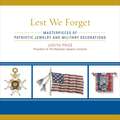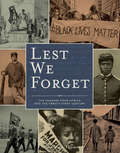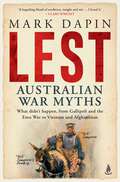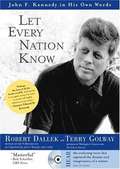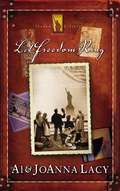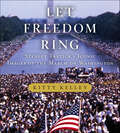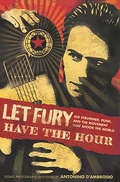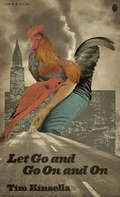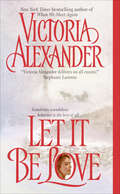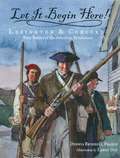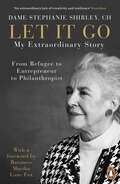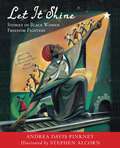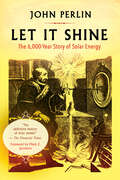- Table View
- List View
Lest We Forget: Masterpieces of Patriotic Jewelry and Military Decorations
by Judith PriceSince ancient times, memorable moments of military history have been commemorated with jewelry, medals, and symbolic accessories. In Lest We Forget: Masterpieces of Patriotic Jewelry and Military Decorations, Judith Price illuminates iconic military objects, exploring their origins and documenting their place in history. The dramatic compilation of patriotic jewelry and decorations presented in Price&’s sixth book tells a truly dazzling story of Western historical conflict and resolution.Lest We Forget serves as a stunning tribute to our men and women in service both past and present. This book derives its title from the poem &“Recessional&” by Rudyard Kipling, often used as a tribute in war memorials, while its contents chronicle our military history since the Revolution through 150 iconic artifacts. It showcases such diverse items as the Washington Peace Medals to the Indians, the earliest Medals of Honor, Civil War Corps badges, British military decorations, and historic French treasures. Drawn from leading world museums and private collections such as the British Museum, the West Point Museum, the Musée de l&’Armée, and the Imperial War Museum, the objects depicted in this book movingly recall the role of decorations and jewelry in commemorating war and peace.
Lest We Forget: The Passage from Africa into the Twenty-First Century
by Velma Maia ThomasAn intimate look at centuries of black history in America with exclusive accounts, photographs, newspaper reproductions, and other documents.One of The Root's Favorite Reads of 2019Presented in three parts—Lest We Forget, Freedom's Children, and We Shall Not Be Moved—this volume brings African American history to vivid and illustrated life. It includes:Lest We Forget: Based on materials from the nationally acclaimed Black Holocaust Exhibit, Lest We Forget documents the plight of an estimated 100 million Africans, from their rich pre-slavery culture to their enslavement in a foreign land. This collection of stirring historic papers, memoirs, personal effects, and photographs presented alongside moving commentary chronicles the unyielding strength of a people who refused to be broken.Freedom's Children: Taste the sweetness of freedom and the bitter struggle for equality through the documents that impacted the lives of an entire race. Freedom's Children vividly presents the heart-wrenching and inspiring account of freedmen and freedwomen during Reconstruction and into the twentieth century.We Shall Not Be Moved: Throughout the twentieth century, African Americans would trouble the waters of America—agitating, challenging, and defying the status quo. We Shall Not Be Moved chronicles the struggles and triumphs of African Americans leading up to and during the Civil Rights Movement. Feel the strength of those entrenched in the fight for justice up through the twenty-first century in an afterword that includes the election of America's first African American president and the beginning of the #BlackLivesMatter movement.With this richly illustrated book, take an intimate and unforgettable journey through more than four centuries of black history.
Lest: Australian War Myths
by Mark DapinFrom Simpson&’s donkey and the Emu War to Vietnam and Ben Roberts-Smith, Australian military history is full of events that didn&’t happen the way most people think they did. In his inimitable style, award-winning author Mark Dapin sets the record straight. Australia has many stories and statues &‘lest we forget&’ our military past. But from Simpson&’s donkey to Ben Roberts-Smith, our history is full of events that didn&’t happen the way most people think they did. The first Anzac Day, for example, was far from being a solemn march – it was a celebration where people dressed as cavemen and dinosaurs, among other things. And is it true that British officers callously dispatched Australian soldiers to their deaths in the Dardanelles, as we&’ve been told? Did we really hate the soldiers returning from Vietnam? Were the white-feather women of the First World War fact or fiction? In his inimitable style, award-winning author and historian Mark Dapin sets the record straight, showing that the reality was often completely different from the myth – and that in celebrating the wrong people we often overlook the real heroes. &‘With Lest, Mark Dapin transforms his trademark humour into serious history … It forces us to look again at stories we think we all know – or should know – and reframe them with intellectual rectitude and rigour … Lest offers new perspectives on the past from one of Australia&’s most interesting and provocative thinkers.&’ Clare Wright
Let Down Your Hair
by Linda Winstead JonesRachel Sommerville was soon to marry a scoundrel. Innocent and untouched, Rachel would never guess at her future husband Daniel's past exploits. But Ronald Connor knew everything about Rachel's betrothed. Daniel had seduced Roland's closest friend, his sister, and spurred the events that led to her untimely demise. Roland planned to turn all of his blame and anger against Rachel and her marriage. He would turn feelings of pure hatred to acts of love, employing his every skill to charm Rachel into a sexual tool--one he could use to humiliate Daniel in his honeymoon bed. But he did not know that once this true lady began to let down her hair, Roland would be the captor of her seductive charms.
Let Every Nation Know: John F. Kennedy in His Own Words
by Robert Dallek Terry GolwayFrom the book jacket: Incorporating a remarkable audio CD of Kennedy's most famous speeches, debates and press conferences, Robert Dallek and Terry Golway bring to life the soaring oratory, marvelous wit and intense drama of Kennedy's words and the events they evoke, including: * The historic "Ask Not" inaugural address * The four debates with Richard Nixon * The famous "City Upon a Hill" speech * His pledge to put a man on the moon before the end of the decade * Addresses to the nation during the Bay of Pigs and the Cuban Missile Crisis * Robert Kennedy's heart-wrenching speech at the Democratic National Convention the year after his brother's death
Let Freedom Reign: The Words Of Nelson Mandela
by André Brink Nelson Mandela Henry RussellOn 10 May 1994, Nelson Mandela became South Africa's first black president, uttering the words 'let freedom reign' as part of his famous inaugural address. More than 100,000 people turned up to hear him speak. Mandela's great skill as an orator has enabled him to use the power of words as an important weapon in his fight against discrimination and injustice in the world. This collection, which marks the 20th anniversary of Mandela's release from prison in February 1990, explores how his electrifying speeches and impressive rhetoric helped bring about social and political change in South Africa, through, among other things, the dismantling of the apartheid system. Throughout his lifetime, Mandela has spoken about and written on such issues as global warming, HIV/AIDS, human rights, racism and discrimination and women's rights, and some of these are showcased in "Let Freedom Reign". In this book, author Henry Russell analyses the linguistic features, content and context of Mandela's speeches, revealing the oratory skill behind this great man's most inspiring words.
Let Freedom Ring
by Sean HannityNow, in Let Freedom Ring, Sean Hannity offers a survey of the world-political, social, and cultural-as he sees it. Devoting special attention to 9/11, the war on terror, and the continuing threat we face at home and abroad, he makes clear that the greatest challenge we have to overcome may not be an attack from overseas, but the slow compromising of our national character. And he asks why, particularly in this time of war, should we entrust our future to the voices of the Left-the very people who have spent decades ravaging so many of our core values and traditions? Our nation, as Hannity reminds us, was founded on the idea of order to protect our freedoms, he argues we must standvigilant "against liberal attempts to compromise our strength sFrom our military and intelligence forces, to our borders and airports, to our unified commitment to root out terrorists at home and abroad, he reveals how our strongest lines of defense have come under attack-by left-wing voices within our government, media, schools, and elsewhere. And he shows how even domestic issues like taxation, education, patriotism, and the family have been exploited by liberals with their own agendas-with potentially disastrous results. Filled with the commonsense commentary and passionate argument that have made Sean Hannity the most compelling conservative voice since Rush Limbaugh, Let Freedom Ring is an urgent call to arms. For, as Hannity warns, "We are engaged in a war of ideas. And civilization is' at stake."
Let Freedom Ring
by Thomas KinkadeThomas Kinkade has always cherished the qualities that make America great. The Painter of Light radiantly imbued each piece of his art with tranquility, love, faith, and family – all attributes of this great nation that has clung together through thick and thin.The words of notable men and women from George Washington to Abraham Lincoln to John F. Kennedy to Katherine Lee Bates add an even greater inspirational touch to Kinkade's glorious art.Copyright 2005 Thomas Kinkade, The Thomas Kinkade Company, Inc., Morgan Hill, CA
Let Freedom Ring (Shadow of Liberty Series #1)
by Al Lacy Joanna LacyYoung Russian Vladimir Petrovna is always minutes away from disaster. He is a Christian in a pagan country that exacts extreme penalties from believers. His farm is nearly destroyed by blight and he cannot pay the taxes he owes. And he is a husband and father of three whose daughter is secretly in love with a Cossack-one of the very soldiers who persecute families like Vladimir's. Though he may lose everything he loves, Vladimir must trust God as he navigates his river of trouble. When he finally arrives in the "land of the free and the home of the brave," his destiny-and faith-is changed forever.From the Trade Paperback edition.
Let Freedom Ring: Stanley Tretick's Iconic Images of the March on Washington
by Kitty KelleyA bestselling author and legendary photographer present an illuminating look at a pivotal moment in our nation's history: The March on WashingtonDespite the heat and humidity, people came in droves from across the country and around the world, heading for the towering spire of the Washington Monument in our nation's capital. All of the marchers—black, white, Christian, and Jew—shared the same dream: freedom and equality for 19 million African Americans. Almost 300,000 strong, the marchers poured into Washington, D.C., to bear witness, to hear the immortal words of Martin Luther King, Jr., and to petition Congress to pass the President's Civil Rights bill.Stanley Tretick, a seasoned photojournalist best known for his iconic images of President Kennedy and his family, was also in the crowd, drawing inspiration from the historic scenes unfolding before him. In this magnificent book, his stirring photographs of that day are published for the first time. Accompanied by an insightful essay and captions from bestselling author Kitty Kelley, as well as a moving foreword by Marian Wright Edelman, Let Freedom Ring commemorates the fiftieth anniversary of the March on Washington and celebrates the crescendo of the Civil Rights movement in America.
Let Fury Have the Hour: Joe Strummer, Punk, and the Movement that Shook the World
by Antonino D'AmbrosioJoe Strummer's untimely death at the age of fifty in December 2002 took from us one of the truly unique voices of modern music. The quintessential Rude Boy, punker, rebel musician, artist and activist, Strummer wrote some of the most important and influential music of the last century including "Guns of Brixton," "The Washington Bullets," "Spanish Bombs," "White Man in Hammersmith Palace," "London's Burning," "Lost in the Supermarket," and "Garageland. " Effectively melding raw creativity with radical politics, Strummer transformed punk rock from its early associations with reactionary, right wing and nihilistic politics into a social movement. From Rock Against Racism to the Anti-Nazi League Festival to supporting the H-Block protests, Strummer and The Clash led the charge for human rights. Let Fury Have the Hour collects articles, interviews, essays and reviews that chronicle Strummer's life both as a musician and a political activist. Included in this collection are essays and interviews by Antonino D'Ambrosio, alongside contributions from Peter Silverton, Barry Miles, Anya Philips, Sylvia Simmons, Vic Garbarini, Caroline Coons, Todd Martens, Joel Schalit and others. This book also includes original lyrics, photography, art, posters, and flyers, and offers the first serious examination of the life of this extraordinary man.
Let Go and Go On and On
by Tim KinsellaLaurie Bird appeared in three films: Two Lane Blacktop, Cockfighter, and Annie Hall. Her fiancé, Art Garfunkel, was away shooting another film, Bad Timing, when she committed suicide at the age of 26. Let Go and Go On and On blurs what little is actually known of her with her roles in these films. Guided by constraints, it is a collage and a loving tribute.
Let It Be Love (Effington Family #11)
by Victoria AlexanderDashing Jonathon Effington, the Marquess of Helmsley, has had more than one lady willingly fall into his arms. But he's so delicious none has ever complained at their inevitable parting. And while Jonathon's no stranger to passion of the flesh, his heart has remained untouched. Until now . . . At each Christmas Ball, Jonathon selects a delectable lady to share the pleasures of the evening--after all, it's a holiday tradition! But he is shocked to discover that his choice is replaced by an enchanting stranger who surprises him with a proposal of marriage. Beautiful Fiona Fairchild is desperate--only a wedding will save her sisters and her inheritance. But Jonathon has no interest in marriage, and what starts as a shocking proposal turns into a scandalous proposition that might ruin them both.
Let It Be Love (The Effington Family #12)
by Victoria Alexander“[A] rollicking historical romance . . . the perfect holiday read” from the #1 New York Times–bestselling author of When We Meet Again (Publishers Weekly).Dashing Jonathon Effington, the Marquess of Helmsley, has had more than one lady willingly fall into his arms. But he’s so delicious none has ever complained at their inevitable parting. And while Jonathon’s no stranger to passion of the flesh, his heart has remained untouched. Until now . . . At each Christmas Ball, Jonathon selects a delectable lady to share the pleasures of the evening—after all, it’s a holiday tradition! But he is shocked to discover that his choice is replaced by an enchanting stranger who surprises him with a proposal of marriage. Beautiful Fiona Fairchild is desperate—only a wedding will save her sisters and her inheritance. But Jonathon has no interest in marriage, and what starts as a shocking proposal turns into a scandalous proposition that might ruin them both . . .“Let It Be Love is fantastic! Humorous, sensuous and touching, it’s a most excellent addition to Victoria Alexander’s Effington family saga.” —Fresh Fiction
Let It Begin Here!: Lexington And Concord - First Battles Of The American Revolution
by Dennis Brindell Fradin Larry DayOn April 18th at 9:30 p. m. Paul Revere learned that the British Army was marching toward Lexington and Concord to arrest rebel leaders. At 5:20 the next morning, a shot rang out and the American Revolution had begun. <P><P> Told in a step-by-step account of the 24 hours leading up to the battles that sparked a revolution, this tale is sure to both inform and entertain.
Let It Destroy You: A Novel
by Harriet Alida LyeInspired by the true story of a dangerous atomic weapon and the man who designed it, here is a stunning novel of morality, creation, and loss from the acclaimed author of The Honey Farm and Natural Killer.It is August 12, 1945. Tomorrow, August Snow will be tried at the International War Crimes Court for patenting a more lethal variation on the atomic bomb. He invented a radiation machine to cure his young daughter&’s cancer, despite knowing that the very same technology was capable of great destruction, and inevitably profited from disaster. But are his intentions relevant when the fate of the world is at stake?August&’s former wife, June, will also attend the hearing. Restless in her Hague hotel room the night before, she keeps watch over their daughter and reflects on the events that brought them here. She had nothing to do with making the bomb. But is she innocent? Wouldn&’t any wife and mother have done the same thing in her shoes? And now, will it cost her everything?Inspired by the physicist Leó Szilárd and the letters he wrote his wife, Gertrud "Trude" Weiss, Let It Destroy You is told in parallel narratives and ventures from Budapest to Berlin to Colorado, and back to Europe. It is a love story about two people whose destinies are bound by everything they share, and all that they&’ve kept from one another. Above all, it is a testament to the logic-defying love of a parent who will stop at nothing to protect their child.
Let It Go: My Extraordinary Story - From Refugee to Entrepreneur to Philanthropist
by Richard Askwith Dame Stephanie Shirley CHA moving memoir from a woman who made a fortune in a man's world and then gave it all away...soon to be turned into a filmIn 1962, Stephanie 'Steve' Shirley created a software company when the concept of software barely existed. Freelance Programmers employed women to work on complex projects such as Concorde's black box recorder from the comfort of their own home. Shirley empowered a generation of women in technology, giving them unheard of freedom to choose their own hours and manage their own workloads. The business thrived and Shirley gradually transferred ownership to her staff, creating 70 millionaires in the process.Let It Go explores Shirley's trail blazing career as an entrepreneur but it also charts her incredible personal story - her dramatic arrival in England as an unaccompanied Kindertransport refugee during World War Two and the tragic loss of her only child who suffered severely from Autism.Today, Dame Stephanie Shirley is one of Britain's leading philanthropists, devoting most of her time, energy and wealth to charities that are close to her heart. In Let It Go, Shirley tells her inspirational story and explains why giving her wealth away - letting it go - has brought her infinitely more happiness and fulfilment than acquiring it in the first place.Co-written with Richard Askwith, the former Executive Editor of The Independent and the award-winning author of seven books in his own name, including biographies of Emil Zátopek and Lata Brandisová.'An extraordinary tale of creativity and resilience' - Guardian'This engrossing story of an extraordinary life is filled with lessons in what it means to be human' - Financial Times
Let It Shine: A gripping saga of greed, integrity and love
by Josephine CoxAs her past catches up with her, can she ever hope to restore happiness? Josephine Cox writes an enthralling saga in Let It Shine - a story of bad choices, family ties and second chances. Perfect for fans of Cathy Sharp and Dilly Court.Ada Williams once believed money and power would bring her happiness. But now she is all alone except for her greedy son Peter, who waits only for the day he will inherit her fortune. Ada, however, has a different plan altogether.A few miles away in Blackburn, the Bolton family may be poor - but the love they share means they can overcome almost any adversity. But no one could foresee the shocking events of Christmas night, 1932, which split the family asunder, leaving Larry crippled and the twins, Ellie and Betsy, in a foster home. Events that began many years ago, when Ada Williams was young and foolish...What readers are saying about Let It Shine: 'I bought this book last night and have not been able to put it down, just finished it and have gone through so many different emotions. First you're laughing, the next tears, the next anger. Then it happens all over again. Fantastic read''Brilliantly written, Josephine provides such an interesting cast of heroes and villains. This novel is Josephine at her best. She is able to make you care about the characters she writes about and keeps you guessing up until to the end'
Let It Shine: A gripping saga of greed, integrity and love
by Josephine CoxAs her past catches up with her, can she ever hope to restore happiness? Josephine Cox writes an enthralling saga in Let It Shine - a story of bad choices, family ties and second chances. Perfect for fans of Cathy Sharp and Dilly Court.Ada Williams once believed money and power would bring her happiness. But now she is all alone except for her greedy son Peter, who waits only for the day he will inherit her fortune. Ada, however, has a different plan altogether.A few miles away in Blackburn, the Bolton family may be poor - but the love they share means they can overcome almost any adversity. But no one could foresee the shocking events of Christmas night, 1932, which split the family asunder, leaving Larry crippled and the twins, Ellie and Betsy, in a foster home. Events that began many years ago, when Ada Williams was young and foolish... What readers are saying about Let It Shine: 'I bought this book last night and have not been able to put it down, just finished it and have gone through so many different emotions. First you're laughing, the next tears, the next anger. Then it happens all over again. Fantastic read''Brilliantly written, Josephine provides such an interesting cast of heroes and villains. This novel is Josephine at her best. She is able to make you care about the characters she writes about and keeps you guessing up until to the end'
Let It Shine: Stories of Black Women Freedom Fighters
by Andrea Davis PinkneyIncludes biographies of Sojournor Truth, Biddy Mason, Harriet Tubman, Ida B. Wells-Barnett, Mary McLeod Bethune, Ella Josephine Baker, Dorothy Irene Height, Rosa Parks, Fannie Lou Hamer, and Shirley Chisholm.
Let It Shine: The 6,000-Year Story of Solar Energy
by John PerlinThe definitive history of solar power and technology Even as concern over climate change and energy security fuel a boom in solar technology, many still think of solar as a twentieth-century wonder. Few realize that the first photovoltaic array appeared on a New York City rooftop in 1884, or that brilliant engineers in France were using solar power in the 1860s to run steam engines, or that in 1901 an ostrich farmer in Southern California used a single solar engine to irrigate three hundred acres of citrus trees. Fewer still know that Leonardo da Vinci planned to make his fortune by building half-mile-long mirrors to heat water, or that the Bronze Age Chinese used hand-size solar-concentrating mirrors to light fires the way we use matches and lighters today. With thirteen new chapters, Let It Shine is a fully revised and expanded edition of A Golden Thread, Perlin’s classic history of solar technology, detailing the past forty years of technological developments driving today’s solar renaissance. This unique and compelling compendium of humankind’s solar ideas tells the fascinating story of how our predecessors throughout time, again and again, have applied the sun to better their lives — and how we can too.
Let Liberty Rise!: How America’s Schoolchildren Helped Save the Statue of Liberty
by Chana StiefelHow did 121,000 Americans save their most beloved icon? Here is an inspiring story about the power we have when we all work together!"All rise to this evocative, empowering offering." -- Kirkus ReviewsOn America's 100th birthday, the people of France built a giant gift! It was one of the largest statues the world had ever seen -- and she weighed as much as 40 elephants! And when she arrived on our shores in 250 pieces, she needed a pedestal to hold her up. Few of America's millionaires were willing to foot the bill.Then, Joseph Pulitzer (a poor Hungarian immigrant-cum-newspaper mogul) appealed to his fellow citizens. He invited them to contribute whatever they could, no matter how small an amount, to raise funds to mount this statue. The next day, pennies, nickels, dimes, and quarters poured in. Soon, Pulitzer's campaign raised enough money to construct the pedestal. And with the help of everyday Americans (including many thousands of schoolchildren!) the Statue of Liberty rose skyward, torch ablaze, to welcome new immigrants for a life of freedom and opportunity!Chana Stiefel's charming and immediate writing style is perfectly paired with Chuck Groenink's beautiful, slyly humorous illustrations. Back matter with photographs included.
Let Loose the Tigers: Passions run high when the past releases its secrets (Queenie's Story, Book 2)
by Josephine CoxAs she retraces her steps back north, Queenie threatens to disturb more than one person's future... In the sequel to Her Father's Sins, Josephine Cox writes a captivating saga in Let Loose the Tigers, in which Queenie returns to Blackburn... and to her past. Perfect for fans of Kitty Neale and Rosie Goodwin.Queenie Bedford fled her native Blackburn and the bitter knowledge that she and Rick Marsden, the man she loved, could never marry. But in 1965 she returns north again to stand by her friend Sheila Thorogood, imprisoned for running a brothel with her mother Maisie. Though Rick had vowed to find her, Queenie takes care that he should not know of her whereabouts.The magnificent Edwardian house in Blackpool is sadly neglected - but Queenie moves in with the ailing Maisie, and sets about transforming it into a sparklingly clean, highly respectable guesthouse. Meanwhile, Queenie meets the frail and confused Hannah Jason, locked away years ago for murder, and desperate for news of her long-lost son. As Rick continues his dogged search for Queenie, she sets out to find Hannah's son. But both their enquiries threaten to unlock the cage where crucial secrets have long been held captive. What readers have been saying about Let Loose the Tigers: 'This book was brilliant, once you pick it up you cannot put it down because you need to know what happens next''Keeps you spellbound till the end'
Let Loose the Tigers: Passions run high when the past releases its secrets (Queenie's Story, Book 2)
by Josephine CoxAs she retraces her steps back north, Queenie threatens to disturb more than one person's future... In the sequel to Her Father's Sins, Josephine Cox writes a captivating saga in Let Loose the Tigers, in which Queenie returns to Blackburn... and to her past. Perfect for fans of Kitty Neale and Rosie Goodwin.Queenie Bedford fled her native Blackburn and the bitter knowledge that she and Rick Marsden, the man she loved, could never marry. But in 1965 she returns north again to stand by her friend Sheila Thorogood, imprisoned for running a brothel with her mother Maisie. Though Rick had vowed to find her, Queenie takes care that he should not know of her whereabouts.The magnificent Edwardian house in Blackpool is sadly neglected - but Queenie moves in with the ailing Maisie, and sets about transforming it into a sparklingly clean, highly respectable guesthouse. Meanwhile, Queenie meets the frail and confused Hannah Jason, locked away years ago for murder, and desperate for news of her long-lost son. As Rick continues his dogged search for Queenie, she sets out to find Hannah's son. But both their enquiries threaten to unlock the cage where crucial secrets have long been held captive. What readers have been saying about Let Loose the Tigers: 'This book was brilliant, once you pick it up you cannot put it down because you need to know what happens next''Keeps you spellbound till the end'
Let Love Find You (Reid Family #4)
by Johanna Lindsey#1 New York Times bestselling author Johanna Lindsey delivers the "potent, sexy chemistry" (Booklist) and witty repartee for which she is adored in this dazzling regency romance about a desperate debutante whose family hires an innovative matchmaker to ensure her marriage.London society has its very own Cupid. Renowned horse breeder and occasional matchmaker Devin Baldwin pairs eligible young ladies with suitable gentlemen based on his theory of animal magnetism. Unafraid of ruffling feathers, this darkly handsome Cupid doles out tips for bettering one's chances of meeting a mate that are as pointed as the love legend's sharpest arrows! Lovely Amanda Locke, the daughter of a duke, is everything a nobleman could desire, yet she enters her third Season still searching for a match. Gossipmongers' tongues are wagging, and her mystified family is considering drastic measures to find her a husband. But the insufferable advice of this Cupid fellow is the last thing Amanda wants. When an earl passionate about horses becomes the target of her husband hunt, Amanda knows it's time to overcome her fear of riding. With her sister-in-law Ophelia hastening the romance along by arranging riding lessons, Amanda is soon taking instruction from infuriating Devin Baldwin. Astonishingly, in her daily encounters with Devin--who treats her as an ordinary young woman, not a prize to be won at the marriage mart--Amanda experiences passion for the first time. Now, her search for a match takes her in an unexpected direction as she finds herself falling in love with Cupid himself.
